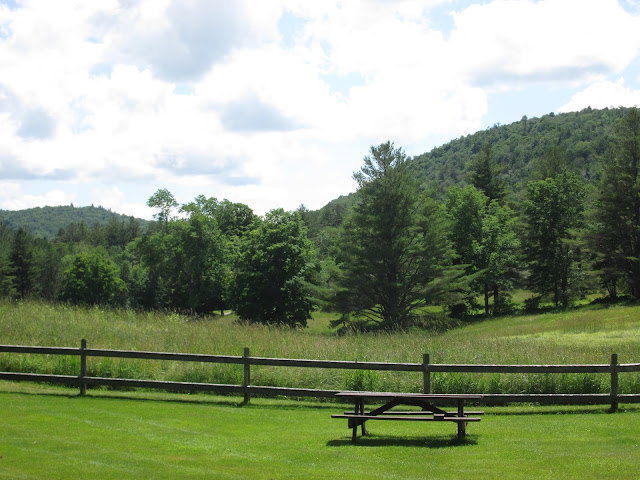Plymouth Notch was/is a tiny village a hour or so north of where I live in Vermont, It was/is one of the villages that make up the town of Plymouth. Once the center of a number of farms, the village had a General Store (which was also the Post Office), a church, a schoolhouse, and a cheese factory among its few buildings. John Coolidge used to own the General Store. His son Calvin was born (in the small cottage attached to the store) on the Fourth of July. After John Coolidge's wife passed, he married the local schoolmarm, and ran the cheese factory. Calvin became a layer, Governor of Massachusetts, and Vice-President of the United States. He was visiting his father at the start of August 1923 when then President Harding suddenly expired. As there was no telephone in Plymouth Notch, messengers had to be sent to tell the Vice President the news. It was early in the morning; John Coolidge had to wake his son, who dressed, said a prayer, and went downstairs where people were waiting. As the father was both a Justice of the Peace and a Notary, he was pressed into service to perform the ceremony swearing his son into office as the 30th President of the United States. After sending a telegram of condolence to Mrs. Harding, the President went back to bed. John Coolidge passed away a couple of years later. His housekeeper refused to change anything in the house. It, and the village, eventually became a historic site. It's all still there.
 |
| Plymouth Notch, VT |
 |
The General Store was bring repainted and was the scene of some confusion with a number of tourists milling around waiting for a tour to begin. I never got a chance to take its picture.
As I don't have the time to dig out one of my old pictures of the place and scan it,
here's a friend's photo in front of the Store - that's his 1948 Dodge in the center. (Nice, huh?) |
 |
Upstairs, over the store, is the old meeting hall, site of dances and etc.
During the President's visit in 1924, it was the Summer White House. |
 |
| At the back of the General Store is the building in which the Coolidge family lived when Calvin was born. |
 |
| Next to the General Store is the village church. |
 |
| The interior is all wood, milled locally. The flag denotes the Coolidge family pew. |

 |
Across the street from the church is the house John Coolidge purchased after he remarried.
The building just up the street is the cheese factory. (The one room schoolhouse is next to it.) |

 |
Inside the Coolidge home, the workroom contained a ball of string.
My family had one in the kitchen when I was young. |
 |
Aside from facilities in the attached barn, just inside the house was a small 'two seater'.
The reading material, emergency paper supply, are seed catalogues.
Sorry about the quality of the photo - everything is glassed in for preservation. |
 |
The dining room - everything is original and as it was.
The second Mrs. Coolidge (the President's Step-Mother) passed on the fainting couch by the windows. |
 |
A detail of the sitting room. On the table is the bible used to swear in the President.
Being a Progressive Republican Vermonter, Mr. Coolidge refused to swear on oath on the bible
and simply held his hand over it. |
 |
| The village's two old barns (one rebuilt and added since I had last visited over 15 years ago) contain farm tools, carriages and the like - donated by local farmers. Everything there was used in the general vicinity. |

Calvin Coolidge is, to this day, the only President of the United States born on the Fourth of July - the date on which the Colonies declared their Independence from Great Britain. My third visit to the site (over 20 years time) was this past Thursday. The first time I was there, it took me a good 20 minutes to figure out why things felt different walking through the village. Then I suddenly realized that there were no utility poles to be seen. There have been changes since my last visit, which include electric lights illuminating exhibits in the barns, a videotape in the Summer White House, etc. It's a shame in a way, as visiting used to be such a step back in time.
My radio show this week took note of some of the other people born on the Fourth of July - lyricist Irving Caesar, songwriter Stephen Foster, songwriter/bandleader John Phillip Sousa, and Louis Armstrong. (Throughout his life, Armstrong thought he was born on the Fourth of July. Later research turned up his baptismal certificate which showed his birthdate as August 4th.) The show also notes George M. Cohan, who was born on July 3rd. As always, I hope any listeners enjoy the show.



















No comments:
Post a Comment